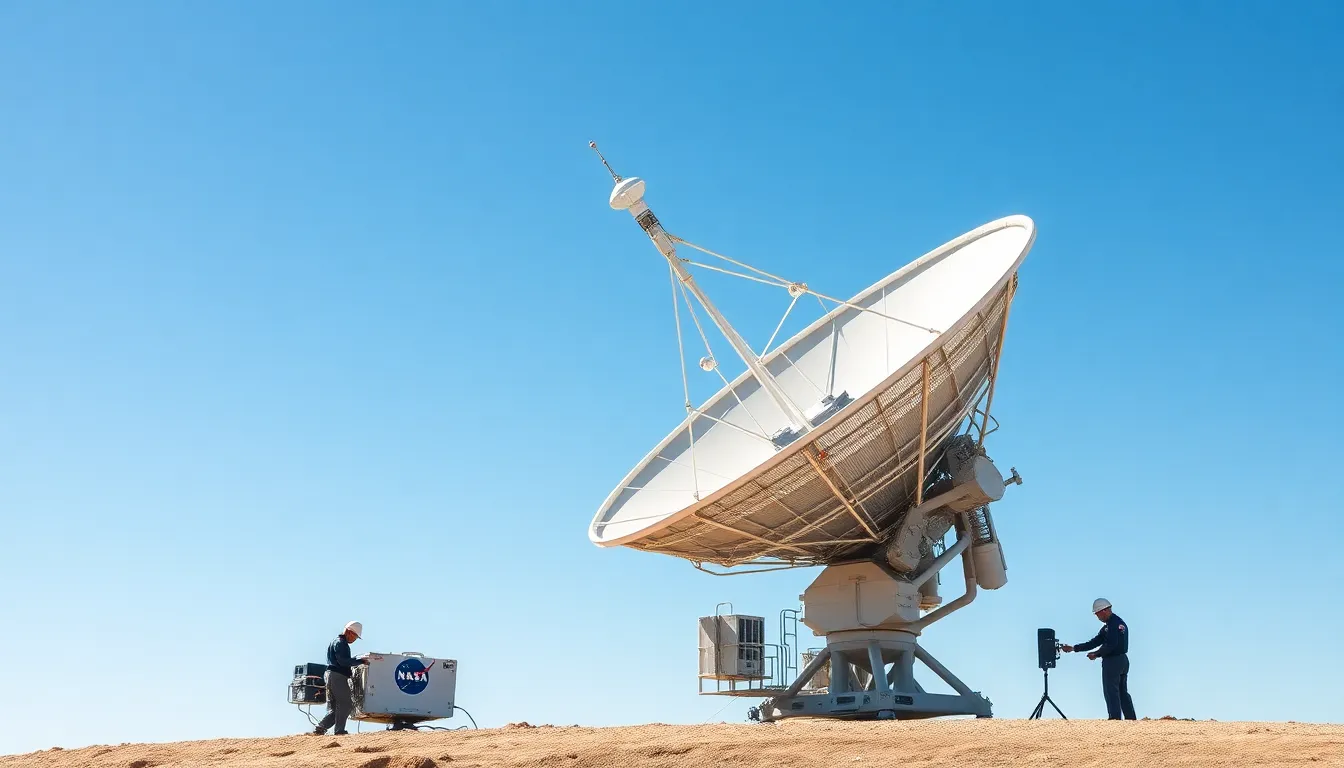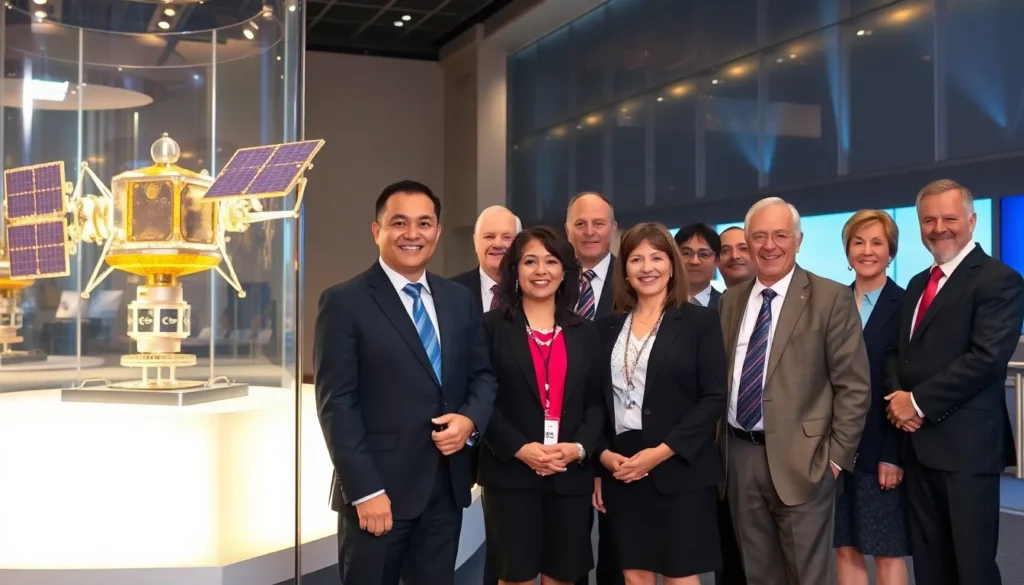In a universe filled with stars, planets, and the occasional space potato, effective communication is essential. Space communication systems are the unsung heroes that keep astronauts connected to Earth, ensuring they don’t accidentally send a “Wish you were here” postcard to the wrong galaxy. From the early days of satellite radio to today’s high-tech laser beams, these systems are crucial for everything from scientific research to interstellar gossip.
Imagine trying to call your friend while they’re floating in zero gravity. Without a reliable communication system, they might think you’re just a distant memory. As technology advances, the way we communicate in space becomes more sophisticated, making it possible to send and receive data faster than you can say “Houston, we have a problem.” Get ready to explore the fascinating world of space communication systems and discover how they keep humanity connected, no matter how far we venture into the cosmos.
Table of Contents
ToggleOverview of Space Communication Systems
Space communication systems play a vital role in connecting astronauts to Earth. These systems enable the transmission of voice, data, and video, ensuring real-time communication critical for mission success.
Early systems relied on satellite radio technology, which provided basic communication capabilities. Today’s systems incorporate advanced technologies, such as laser and radio frequency communications. Innovations in these areas lead to faster data transfer rates and improved signal clarity, enhancing the overall quality of communication.
Satellite constellations offer extensive coverage for global communication. Systems like NASA’s Tracking and Data Relay Satellite System (TDRSS) facilitate continuous communication with spacecraft in low Earth orbit. These satellites create a network that ensures seamless contact, regardless of the spacecraft’s position.
Laser communication systems represent a significant advancement. They can transmit data at much higher rates than traditional radio systems, benefiting data-intensive missions like those involving scientific research. Ongoing projects aim to enhance laser communication technology for interplanetary missions, enabling efficient data transfer from Mars or beyond.
Robust ground stations are essential for supporting space communication. These facilities house powerful antennas and processing equipment, allowing them to receive signals from space and relay information back to astronauts. Proper maintenance of ground stations ensures reliable performance during critical mission phases.
Understanding the various components of space communication systems underscores their importance in maintaining astronaut connectivity. As exploration efforts expand, technological improvements will continue to optimize these systems, reinforcing their role in supporting future missions.
Types of Space Communication Systems

Various types of space communication systems facilitate critical connections between astronauts and Earth. These systems include ground-based, space-based, and hybrid systems.
Ground-Based Systems
Ground-based systems consist of terrestrial networks that manage communication between satellites and control centers. These systems utilize large antennas and towers to relay signals. Stations like NASA’s ground facilities employ high-frequency radios to communicate effectively with spacecraft. Features of ground-based systems include a robust infrastructure that allows for extensive coverage and improvement in signal reception. Integration of advanced technologies enhances data processing capabilities, ensuring efficient transmission of voice, video, and telemetry data.
Space-Based Systems
Space-based systems utilize satellites positioned in orbit to relay information. These satellites, such as those in the Tracking and Data Relay Satellite System (TDRSS), maintain constant communication with spacecraft. Multiple satellites create a network to improve signal strength and coverage. Innovations in radio frequency and laser communication technologies enhance data transfer rates in these systems. The benefits include reduced latency and the ability to transmit large amounts of data swiftly.
Hybrid Systems
Hybrid systems combine ground-based and space-based technologies to increase communication efficiency. They utilize the strengths of both systems, resulting in a more robust communication network. Ground stations coordinate with satellites to optimize data flow and ensure reliable connections. Implementing laser communication within hybrid systems achieves faster data transmission, catering to data-intensive operations. The combination of these systems enhances mission success by providing diverse communication pathways.
Key Technologies in Space Communication
Space communication relies on several key technologies that evolve continuously to support astronauts and spacecraft. These technologies facilitate vital voice, data, and video transmission, ensuring effective communication even in remote environments.
Radio Frequency Communication
Radio frequency communication remains foundational in space communication systems. This technology utilizes radio waves for data transmission between spacecraft and ground stations. Various frequency bands, such as S-band, X-band, and Ku-band, offer different capabilities, delivering audio, telemetry, and video signals. X-band, for instance, provides higher data rates suitable for scientific missions. Ground-based antennas capture signals effectively, while the design of spacecraft antennas enhances communication quality. Reliability and coverage often improve through cluster arrangements of satellites in orbit.
Optical Communication
Optical communication technology employs lasers to transmit data over long distances. This method predominately features higher data transfer rates compared to traditional radio frequency systems. Laser beams carry signals through the vacuum of space, minimizing signal degradation. NASA’s Laser Communications Relay Demonstration conducted tests confirming the technology’s potential for missions requiring substantial data exchange. By using optical communication, astronauts can share large scientific datasets promptly, enabling faster decision-making on missions.
Quantum Communication
Quantum communication introduces an innovative approach to secure data transmission. This technology harnesses quantum mechanics principles to enhance communication security and minimize interception risks. Quantum key distribution, a critical component, allows for the creation of uncrackable encryption keys that protect sensitive information. As space exploration advances, quantum communication systems could significantly impact mission safety and ensure secure communications. Experimentation with quantum technologies in space showcases their potential for future missions, enabling a new frontier in secure data transfer.
Challenges in Space Communication
Space communication encounters multiple challenges that affect data transmission and signal quality. Among these challenges are signal loss and delay, along with interference and jamming.
Signal Loss and Delay
Signal loss occurs due to the vast distances that signals must traverse in space. Over these distances, attenuation can diminish signal strength. Atmospheric conditions like solar storms or heavy radiation can exacerbate this issue, leading to greater delays in communication. It’s critical for mission success to acknowledge these delays, which can range from several milliseconds to multiple seconds. High-frequency radio waves, commonly used for communication, are more susceptible to such losses. To combat these problems, innovative solutions like adaptive coding and modulation techniques play a significant role in enhancing signal integrity and minimizing delays.
Interference and Jamming
Interference poses another significant threat to reliable space communication. Natural interference from celestial phenomena, such as cosmic rays, can disrupt signal clarity. Additionally, artificial jamming from ground-based sources can hinder effective communication. Jamming intentionally disrupts signals, creating communication barriers that can jeopardize mission safety. Implementing advanced error correction methods and frequency hopping techniques helps mitigate these risks. Investments in resilient technologies, capable of overcoming both natural and man-made disturbances, remain essential to maintain seamless communications in space.
Future Trends in Space Communication Systems
Advancements in space communication systems continuously reshape the landscape of aerospace technology. As innovations emerge, they play a crucial role in enhancing data transmission methods.
Advancements in Technology
New developments in satellite technology contribute to faster data transfer rates. Laser communication systems, for example, transmit data with significantly less signal loss compared to traditional radio frequency methods. Increased utilization of small satellite constellations offers extensive coverage and flexibility for various missions. Enhanced ground station capabilities deepen the reliability of communications through improved signal processing techniques. Quantum communication technologies provide an unprecedented level of security, making it nearly impossible for transmissions to be intercepted. Groundbreaking error correction algorithms further optimize system performance by maintaining signal integrity over vast distances.
Emerging Applications
Space communication systems now extend beyond traditional uses. Telemedicine allows remote diagnosis and treatment of astronauts during long missions. Earth observation satellites utilize advanced communication systems for real-time data sharing, benefiting environmental monitoring. Remote sensing technology enables scientists to gather crucial data for climate research and land management. Exploration missions benefit from high-capacity transmissions, enabling detailed scientific analysis of other planets. Additionally, commercial spaceflight ventures require robust communication systems to ensure passenger safety and mission success. Enhanced connectivity options support educational outreach, allowing students worldwide to engage with space missions in real-time.
Space communication systems are essential for maintaining connections between astronauts and Earth. As technology evolves these systems become more sophisticated and capable of handling the demands of modern space missions. The integration of advanced communication methods not only enhances mission success but also fosters personal connections and scientific collaboration.
With the rise of laser communication and hybrid systems the future of space communication looks promising. Continued innovations will address existing challenges while expanding the capabilities of these systems. As humanity ventures further into the cosmos the importance of reliable communication will only grow, making these advancements crucial for exploration and research.




